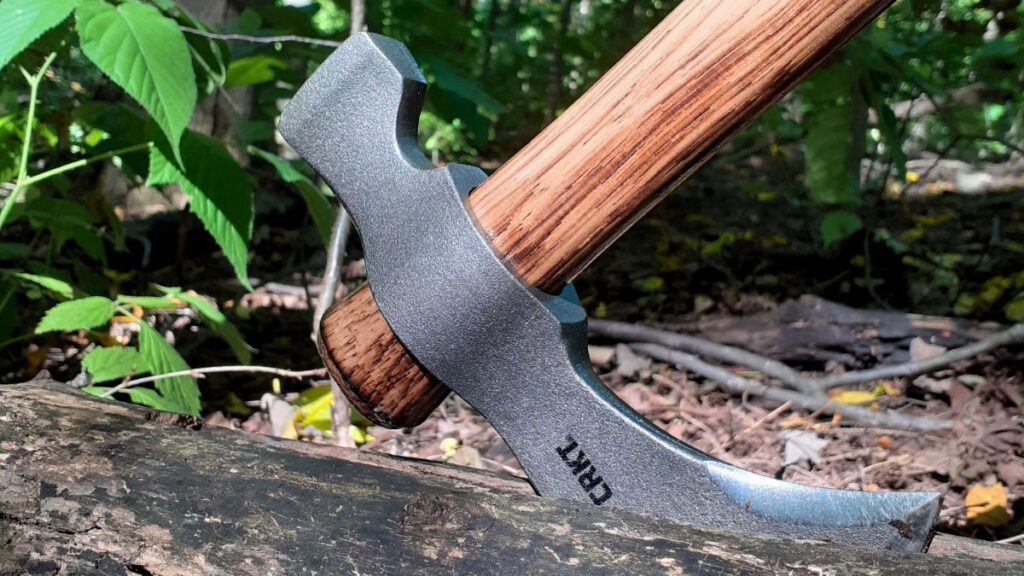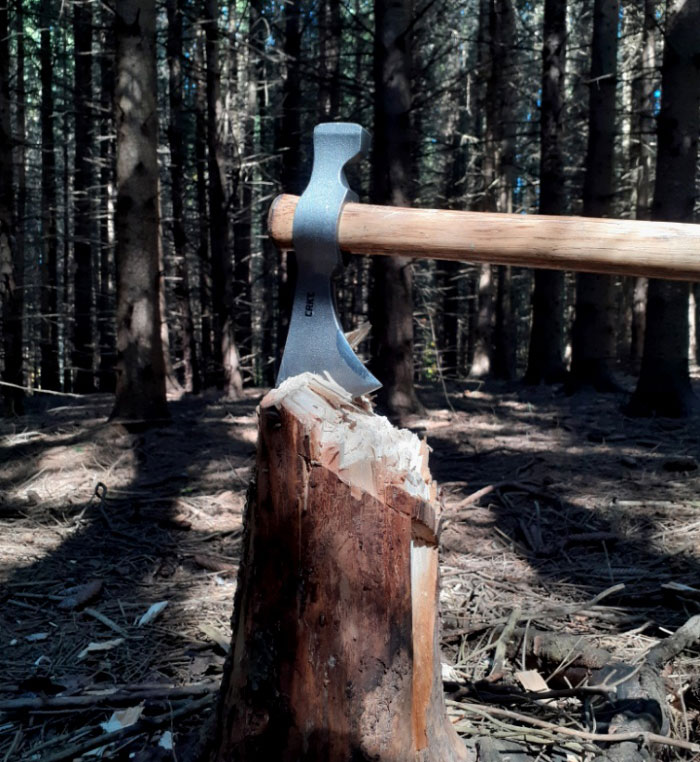
I have been patiently waiting to get my hands on a tomahawk for a few years now. So much so that when I connected with a representative from CRKT and finally got the opportunity to get my hands on one, I was so excited that I monitored the tracking service every day like a kid counting down the days until Christmas until it arrived at my doorstep.
by Logan Misseldine, contributing writer
The biggest reason I’ve been wanting to invest in a tomahawk is to lighten my loadout while still being able to keep the same pace with my normal gear. I am what you could call a chronic over packer, I always end up bringing way too much gear with me thinking that my trips will be more successful if I’m over prepared. The CRKT Woods Chogan T-Hawk to me represents the idea of being able to complete complicated tasks with less and/or lighter gear.
Buying the CRKT Woods Chogan T-Hawk
If, after reading this article, you are considering buying the Chogan T-Hawk, there are three main places that sell it. Prices vary over time, but as of this writing, Bass Pro Shops has the best pricing, and if you use the Rakuten Chrome extension, it will give you another 3.5% in cash back.
| Woods Chogan T-Hawk Sellers |
|---|
| Amazon |
| Bass Pro Shops |
| CRKT |
Tomahawks for Prepping
To me, the right tomahawk can be an excellent tool for a plethora of uses. Depending on the specifications of your “hawk,” it can bridge the gaps between axe and knife; sturdy enough to handle chopping firewood while delicate enough to process game and perform other intricate work. And there are plenty of reasons why the tomahawk is a perfect survival tool.
Hawks are typically considered jacks of all trades. They are not for one specific task, nor are they intended to be. Being more lightweight and easier to handle than an axe or hatchet can be an advantage when weight and maneuverability are paramount to the situation, whether that is chopping through material or splitting zombie heads open.
While tactical tomahawks have made waves across the prepping scene (for good reason), the traditional two-piece hawk (like this Woods Chogan T-Hawk) has been around for centuries and has been an effective tool during that time. This design allows you to replace the handle if it were to break. This also grants easier access to the blade and head for sharpening and maintenance.
CRKT Woods Chogan T-Hawk Specifications
The Woods Chogan T-Hawk is a tomahawk designed by Ryan Johnson of RMJ Tactical to make off-grid camp chores easier. Both Ryan and RMJ, located in Tennessee, have a great reputation among preppers and servicemen alike for both the design and construction of their products.
The head of the Woods Chogan is made from hot forged 1055 carbon steel with a clear lacquered and hammered finish.
Blade End
The blade is 3.5 inches long and .52 inches thick.

Hammer Head
The hammer on the backside is designed with a groove to make room for your hand to fit underneath it and the blade’s beveled beard.

Handle
The tapered handle is made from Tennessee hickory, which is sealed with a lacquer coat to improve its durability no matter the conditions you use it in. When the head and handle are put together it is 19 inches long and weighs a total of 1.99 pounds.
First Impressions of the Woods Chogan
The first thing I noticed was how nice the aesthetics were right out of the box, the metal and wood paired nicely, and putting them together was a breeze. For being under $100, both the handle and the head felt very well made and durable before I even took a swing.
Blade
The blade was covered by an inexpensive plastic sheath, yet when I removed it, I was confused to find that the blade was rather dull. After some research I found out this is a controversial safety practice that many companies employ to make sure that no one cuts themselves. Whether or not you agree with this, it only took a little effort to get it sharp enough. The Woods Chogan does not come with a sheath, but one is available for purchase on the CRKT website. I’m temporarily borrowing my axe’s sheath until I can get one.
Balance
My first few one-handed practice swings proved to be a little clunky until I found the right place on the handle on the grip. The handle is designed to be used with either one and two hands. Its longer length and the weight of the head make it a little top heavy and harder to manipulate one handed when gripping near the bottom of the handle. If you are looking for a fighting tomahawk, this certainly would get the job done if you were to practice and learn it well, but there are better suited fighting hawks out there.
Handle
I don’t have any real qualms with the handle, the grain and finish pair nicely together for an attractive look in any lighting. It is also well crafted to fit the head snug without any play. You can easily slide your hand up and down to get the proper grip for the job at hand. I am convinced that the handle will last for a few years even under tough conditions and abuse.
Testing the Woods Chogan
Hunting season starts in September first here in Western New York, with squirrels and crows being the first available game. Since I was finally able to get out the third weekend of September, I decided that the best way I could test the hawk would be to bring it on an overnighter to my favorite nearby state forest (also read my Are National Parks Good Bug Out Locations? article).
After an unproductive day, I returned to camp to get my fire started and test out the tomahawk. My camp for this weekend was inside of a man-made pine plantation which provides both ample shelter and dry wood all year round.

Processing Firewood
I started out with clearing off the short dead twigs still attached to the trunk. The Woods Chogan sent each one flying with little effort. I made quick work up the length of the trunk. Next I began to section out the tree into easy to burn logs, and while it may have taken me more swings than if I had used a traditional-sized axe, the smaller and lighter tomahawk gave me the advantage of being able to swing fast and accurately to make up the difference.
Testing the Hammer
After I got through a few cross sections, I decided to move on to using the hammer. I couldn’t find a good log to hammer the blade down as a wedge to split the logs, so I tested the hammer by hammering on my Estwing axe which served as a wedge to split the gnarled pine logs.
The hammer end is my favorite use of the Woods Chogan. There’s something about the added length of the handle and the top-heavy nature of the head that made hammering a rather satisfying endeavor. I couldn’t help but smile and shout my approval with each satisfying contact of metal on metal, and if it weren’t for some nasty and annoying knots in the wood, I would have split the logs in a matter of minutes. Even after some misses there were only a few blemishes on the hammer’s face.
Portability
Compared to the full-sized camping axe I normally try to take with me, I barely felt this tomahawk once I secured it onto my day bag. The aftermarket sheath allows you to secure the tomahawk with three straps and belt loop for effective travel and deployment while on the move. Yet despite not having the sheath I was able to improvise in several ways.
Final Thoughts on the Woods Chogan
I only needed to use this tomahawk for about an hour, and in that amount of time have already fallen in love with it. I plan on taking it with me into the next few years of expeditions with confidence and enthusiasm. If I care for it through proper maintenance, I’m confident that it will tackle anything I throw at it with ease and grace. While being a less than ideal self-defense weapon, this pint-sized hawk is an absolute beast when it comes to processing natural materials.
Sure, you may not be able to fell a sequoia, but do you really need to? If you’re like me and enjoy a good solo trip into the backcountry, between the ability to fully swing with two hands and the tough durability of the steel, this tomahawk will be more than capable of handling the challenges you’ll face. If you’re looking for an introduction to using tomahawks for bushcraft skills, or even as a tool to teach a beginning outdoorsman/outdoorswoman, you really can’t beat the Woods Chogan for its price, quality of construction, and ease of use.
Be sure to tell us your opinions or tips on using the tomahawk(s) you have used down in the comments below.

2 comments
Don’t fall for ridiculous marketing distraction, shipping dull cutting tools is not a “safety feature”, it’s a cost-cutting measure. Hand grinding to get blades sharp costs money. I have never received a dull knife from Spyderco or Kershaw, and very few from other manufacturers. With CRKT, on the other hand, every single knife (out of about 6) was dull, saved for 1 of 2 “Ripple” knives designed by Ken Onion. They do have some interesting designs, but Fit and Finish is spotty except for their upper range, and just about everything is dull dull dull. This axe looks nice, and axes don’t need to be as sharp as knives, but still–I hate having to sharpen new knives. It’s like selling shoes without eyelets for laces.
I got one of these at academy on clearance about 4 years ago. I love it. it is strapped to my GHB (bought the sheath from CRKT).
it has been on quite a few camping/hunting trips and performed very well. once it has an edge, it is def. tempered/hardened well enough to keep it. it is big enough to cut up firewood, but small enough to shave down a piece of oak or hickory to build a spoon, but i have huge yeti hands, i don’t know how well that would work for someone else, but i love the thing.